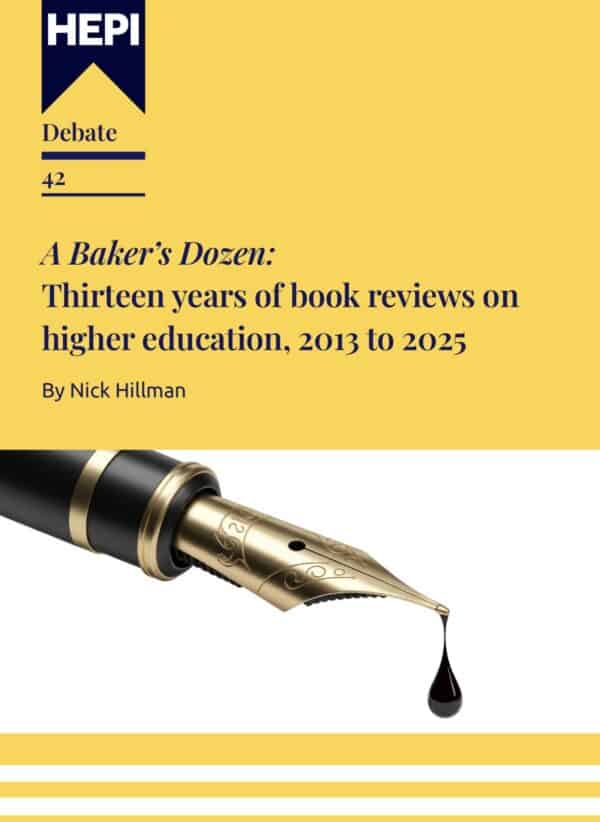Graduate apprenticeships are failing to scale in Scotland – here’s why
This HEPI blog was authored by Elaine Jackson, Lecturer in Business and Management at the University of the West of Scotland.
Imagine earning a full salary while studying for your degree, graduating debt-free, and having a guaranteed job at the end. This isn’t fantasy, it’s exactly what graduate apprenticeships offer. Yet these programmes represent just 8% of Scotland’s university intake, despite employers desperately needing skilled workers in the very sectors where apprenticeships thrive.
The story of what’s possible starts with people like Donna. Through her graduate apprenticeship with a Local Authority, she delivered a project that secured £280,000 in funding and earned recognition as a nominee for the 2025 Convention of Scottish Local Authorities (COSLA) excellence awards. Her success demonstrates the transformative potential of combining work and study but it also highlights a troubling question: if graduate apprenticeships work so well, why aren’t there more of them?
Graduate apprenticeships (GAs), also known as Degree Apprenticeships (DAs) in the UK, represent a specific model of work-based learning where the apprentice is an employee who is simultaneously studying for a full undergraduate or master’s degree. These programmes typically last three to six years, with apprentices spending approximately 20% of their time studying and 80% working.
The scale challenge reveals a deeper problem
The numbers reveal a stark reality. Since these programmes launched in 2017, only 37,000 Scots have enrolled in Foundation and Graduate Apprenticeships combined across all years combined. To put that in perspective, 16,340 Scottish 18-year-olds accepted traditional university places in just 2024 alone. Graduate apprenticeships are growing alongside regular university degrees, offering an alternative pathway rather than replacing traditional routes, but they’re growing far too slowly.
This slow growth becomes even more puzzling when we consider the demand. Skills Development Scotland reports that social work faces a 9.3% vacancy rate, while engineering, digital technology, healthcare, and business management show similar patterns of unmet need. These are exactly the sectors where graduate apprenticeships are proving most successful, yet only 1,378 new opportunities are projected for 2024-25 across all Scottish universities.
So, what would realistic growth look like? Based on current university capacity, documented employer partnerships, and persistent skills shortages, Scotland could reasonably support 2,000-2,500 new apprentices each year, nearly doubling current numbers. This figure accounts for genuine employer capacity to provide meaningful workplace learning, not just any company willing to take on apprentices. It represents growth that the system could absorb without compromising quality.
But three fundamental barriers prevent this expansion from happening and understanding them reveals why good intentions alone aren’t enough to scale successful programmes.
Why growth remains elusive: Three critical barriers
The first barrier is financial, and it’s more complex than simply needing more money. Graduate apprenticeships cost significantly more to deliver than traditional degrees, yet they’re funded as if they were the same thing. Think about how a typical university lecture works: one professor teaches 200 students in a hall, students complete assignments independently, and most learning happens through individual study. Now consider how apprenticeships work: Glasgow Caledonian University provides one-to-one mentoring and three-way liaison between each student, their employer, and university staff throughout the entire programme. Class sizes on these programmes are typically 15-35 students, not 200, and every apprentice needs dedicated support to balance work and study successfully.
This intensive approach works, apprentices like Donna achieve remarkable outcomes. But it is expensive. Evidence from England’s apprenticeship system shows funding ranges from £1,500 to £27,000 depending on complexity, with degree-level programmes requiring the higher amounts. Yet Scottish universities, already facing a £4,000 to £7,000 funding gap per student, receive the same amount whether they’re delivering a large lecture or providing intensive one-to-one support. This creates a perverse incentive: the better the apprenticeship programme, the more money the university loses.
The second barrier involves employer readiness, and here Scotland faces a fundamental difference from countries where apprenticeships work at scale. In Germany and Switzerland, companies must meet standardised quality criteria before they can take on apprentices. They need qualified supervisors, structured learning programmes, and formal assessment processes. This ensures every apprentice receives genuine training, not just a work placement.
Scotland takes a different approach: any employer can participate without meeting specific training standards. While this sounds more flexible, it creates wildly inconsistent experiences. Some employers, like those partnering with the University of the West of Scotland, provide excellent mentoring and career development. Others treat apprentices more like temporary staff, offering limited learning opportunities. This inconsistency doesn’t just harm individual apprentices, it undermines confidence in the entire system, making other employers hesitant to participate and students uncertain about programme quality.
The third barrier is bureaucratic complexity that would frustrate even the most determined institutions. Universities wanting to create new apprenticeship programmes must navigate approval processes across Skills Development Scotland, degree-awarding bodies, and professional accreditation requirements. The Scottish Funding Council’s guidance spans multiple pages covering compliance requirements across 14 different subject areas. When universities are already struggling financially, investing scarce resources in complex approval processes for programmes that may not even cover their costs becomes increasingly difficult to justify.
These barriers explain why graduate apprenticeships remain promising but small-scale, despite clear demand from both employers and students. Early evidence suggests positive retention outcomes among graduate apprentice cohorts, though comprehensive longitudinal data is still emerging given the programmes’ recent introduction. This contrasts with broader patterns where Scotland faces challenges retaining skilled graduates, particularly in STEM fields where migration to other regions for career opportunities remains a persistent concern.
The investment case
The solutions are straightforward, though not simple to implement. First, funding must reflect delivery reality. Universities need premium funding of 125-135% of standard degree rates to cover the intensive support that makes apprenticeships effective. Given that Scottish universities already receive £2,020 less per student than English institutions, this investment would address both general underfunding and apprenticeship-specific costs.
Second, Scotland should build employer capacity systematically rather than simply recruiting more participants. This means developing quality standards for workplace learning, supporting successful employers to mentor others, and focusing on sustainable growth rather than rapid expansion that compromises quality.
Third, approval processes need streamlining. Rather than navigating multiple agencies with overlapping requirements, universities should face consolidated processes that maintain quality while reducing bureaucratic barriers to innovation.
The investment required, approximately £20-35 million annually to reach 2,000-2,500 starts, is significant but justified. Graduate apprenticeships address multiple policy priorities simultaneously: reducing student debt, developing skills where shortages are most acute, and retaining talent in Scotland rather than losing graduates to other regions.
Funding viability: A realistic investment in Scotland’s economic future
The question of funding viability deserves a data-driven response. The proposed £20-35 million annual investment represents just 0.03-0.06% of Scotland’s £59.7 billion public budget—smaller than typical annual budget variations. Scotland already invests £185 million annually in apprenticeships, making this 11-19% increase both modest and strategically targeted.
A phased expansion demonstrates fiscal responsibility while addressing urgent skills gaps. Starting with £15 million (expanding from 1,200 to 1,500 graduate apprentices), scaling to £25 million by year three (2,000 apprentices), and reaching £35 million by year five (2,500 apprentices) aligns expansion with demonstrated employer capacity while allowing quality oversight.
This investment timeline is economically viable because Scotland’s economy is projected to achieve 1.7% growth by 2027. Based on Scottish Fiscal Commission projections of economic growth averaging 1.5% over the implementation period, the apprenticeship investment would represent less than 1% of projected economic expansion—a sustainable allocation that directly addresses the 9.3% vacancy rate in social work and similar shortages across engineering and digital sectors.
International benchmarking supports this scale. England’s apprenticeship system spends £1,500-27,000 per apprentice depending on complexity, with degree-level programmes requiring higher investments. Scotland’s proposed £14,000-20,000 per graduate apprentice (including university premium funding) sits within this proven range while delivering superior outcomes through integrated workplace learning.
The return on investment is compelling: each graduate apprentice avoids approximately £15,000 in student debt compared to the Scottish average, while earning during their studies and contributing immediately to productivity. Graduate apprentices also avoid the debt burden that affects traditional students, providing a genuine alternative to debt-financed higher education.
Rather than adopting loan models that would undermine the fundamental “earn while learning” proposition, Scotland should view this as infrastructure investment—comparable to the £150 million being invested in offshore wind manufacturing. Both create sustainable employment, address skills shortages, and position Scotland competitively in growth sectors. Analysis of successful apprenticeship systems consistently shows that sustainable models rely on public investment rather than employer or student financing.
The choice is strategic, not fiscal. Scotland can afford this investment; the question is whether it can afford not to make it when facing documented skills shortages in sectors critical to economic growth and the net-zero transition.
Conclusion
The choice facing Scottish policymakers is ultimately about ambition and fiscal realism. The evidence shows what works, the economic case is compelling, and the investment is demonstrably affordable through phased implementation. Scotland can accept that graduate apprenticeships remain a valuable but limited option, or it can make a modest, strategic investment to unlock their transformative potential for addressing skills shortages and retaining talent. Now it’s time to scale what works.







Comments
Gavin Moodie says:
Thanx for this. Do employers offer enough apprenticeships? In other Anglophone countries employers do not offer enough apprenticeships or even work experience placements to meet the demand from prospective apprentices.
Reply
Niall Bradley says:
Thank you for setting out the challenges and the case for change in this article. It is helpful to have this set out so succinctly and compellingly.
Reply
albert wright says:
I totally support this approach and would like to see the number of degree apprenticeships double in the next 3 years as they are a win, win, win for the student apprentice, the employer and society at large.
If additional funding were required I think this should come from the apprentice and the employer as they currently get the best deal from the current model
Reply
Thomas Peschken-Holt says:
Thank you. A nice overview of some of the challenges. I would add a structural challenge contributing to the scaling difference between England and Scotland. In Scotland there is no incentive for organisations to participate unless they already recognise the need for skill development; in England, employers loose their ringfenced apprenticeship levy if they do not engage employees in some apprenticeships. It sounds crude but it would point employers that are currently not aware of GAs towards them.
Reply
Add comment